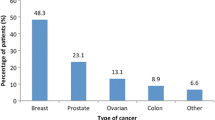Abstract
The United States National Cancer Institute (NCI) supports complementary and alternative medicine (CAM) research which includes different methods and practices (such as nutrition therapies) and other medical systems (such as Chinese medicine). In recent years, NCI has spent around $120 million each year on various CAM-related research projects on cancer prevention, treatment, symptom/side effect management and epidemiology. The categories of CAM research involved include nutritional therapeutics, pharmacological and biological treatments, mind-body interventions, manipulative and body based methods, alternative medical systems, exercise therapies, spiritual therapies and energy therapies on a range of types of cancer. The NCI Office of Cancer Complementary and Alternative Medicine (OCCAM) supports various intramural and extramural cancer CAM research projects. Examples of these cancer CAM projects are presented and discussed. In addition, OCCAM also supports international research projects.
Similar content being viewed by others
References
U.S. Congress, Office of Technology Assessment. Unconventional cancer treatments, OTA-H-405. Washington, DC: U.S. Government Printing Office, September 1990.
Ellison NM, Byar, DP, Newell GR. Special report on Laetrile: the NCI Laetrile Review. Results of the National Cancer Institute’s retrospective Laetrile analysis. N Engl J Med 1978;299:549–552.
http://www.cancer.gov/cam/attachments/nci_cam_annual_report_fy09.pdf
Pan MH, Hsieh MC, Kuo JM, Lai CS, Wu H, Sang S, et al. 6-shogaol induces apoptosis in human colorectal carcinoma cells via ROS production, caspase activation, and GADD153 expression. Mol Nutr Food Res 2008;52:527–537.
Wu H, Hsieh MC, Lo CY, Liu CB, Sang S, Ho CT, et al. 6-shogaol is more effective than 6-gingerol and curcumin in inhibiting 12-O-tetradecanoylphorbol 13-acetateinduced tumor promotion in mice. Mol Nutr Food Res 2010;54:1296–1306.
National Center for Chronic Disease Prevention and Health Promotion and Centers for Disease Control and Prevention (1996). Physical activity and health: a report of the surgeon general. Retrieved June 26, 2009, from: http://www.cdc.gov/nccdphp/sgr/sgr.htm
Peters TM, Shu XO, Moore SC, Xiang YB, Yang G, Ekelund U, et al. Validity of a physical activity questionnaire in Shanghai. Med Sci Sports Exerc 2010;42:2222–2230.
Shankar S, Ganapathy S, Hingorani SR, Srivastava RK. EGCG inhibits growth, invasion, angiogenesis and metastasis of pancreatic cancer. Front Biosci 2008;13:440–452.
Zhou JR, Li L, Pan W. Dietary soy and tea combinations for prevention of breast and prostate cancers by targeting metabolic syndrome elements in mice. Am J Clin Nutr 2007;86:s882–s888.
Ye M, Liu Sh, Jiang Z, Lee Y, Tilton R, Cheng YC. Liquid chromoatography/mass spectrometry analysis of PHY906, a Chinese medicine formulation for cancer therapy. Rapid Commun Mass Spectrom 2007;21:3593–3607.
Lam W, Bussom S, Guan F, Jiang Z, Zhang W, Gullen E, et al. The four-herb Chinese medicine PHY906 reduces chemotherapy-induced gastrointestinal toxicity. Sci Transl Med 2010;2:45ra59.
Zhang R, Li A, Liu B, Wang L, Xin J, Ren K, et al. Electroacupuncture attenuates bone cancer-induced hyperalgesia and inhibits spinal preprodynorphin expression in a rat model. European Journal of Pain 2008;12:870–878.
Aung HH, Dey L, Mehendale S, Xie JT, Wu JA, Yuan CS. Scutellaria baicalensis extract decreases cisplatininduced pica in rats. Cancer Chemother Pharmacol 2003;52:453–458.
Mehendale RS, Aung HH, Yin JJ, Lin E, Fishbein A, Wang CZ, et al. Effects of antioxidant herbs on chemotherapyinduced nausea and vomiting in a rat-pica model. Am J Chin Med 2004;32:897–905.
Li B, Wang C, He T, Yuan C, Du W. Antioxidants potentiate American ginseng-induced killing of colorectal cancer cells. Cancer Letters 2010;289:62–70.
Kawasaki BT, Hurt EM, Mistree T, Farrar WL. Targeting cancer stem cells with phytochemicals. Mol Interv 2008;8:174–184.
Kawasaki BT, Hurt EM, Kalathur M, Duhagon MA, Milner JA, Kim YS, et al. Effects of the sesquiterpene lactone parthenolide on prostate tumor-initiating cells: an integrated molecular profiling approach. Prostate 2009;69:827–837.
Crea F, Mathews LA, Farrar WL, Hurt EM. Targeting prostate cancer stem cells. Anticancer Agents Med Chem 2009;9:1105–1113.
Wang E, Bussom S, Chen J, Quinn C, Bedognetti D, Lam W, Guan F, et al. Interaction of a traditional Chinese Medicine (PHY906) and CPT-11 on the inflammatory process in the tumor microenvironment. BMC Med Genomics 2011;4:38.
Meng Z, Yang P, Shen Y, Bei W, Zhang Y, Ge Y, et al. A pilot study of Huachansu in patients with hepatocellular carcinoma, non small-cell lung cancer, or pancreatic cancer. Cancer 2009;115:5309–5318.
http://projectreporter.nih.gov/project_info_description.cfm?projectnumber=5U19CA128534-03
Fan HT, Li J, Chen X, Lin HS, Trivett A, Stull S, et al. The anti-proliferative effects of herbal medicine Sheng Qi Formula (SQF) on breast tumor 4T1 cell are based on induction of apoptosis. In: The NCI Tenth Annual CCR Fellows and Young Investigators Colloquium, abstract book. Hershey, PA; 2010:14.
http://www.cancer.gov/cam/attachments/cam-newsspring-2009._2009.pdf
http://www.cancer.gov/cam/newsletter/2009-spring/rare_plant_compounds_at_NCI.html
http://www.cancer.gov/cam/newsletter/2010-spring/news_from_the_field_spring2010.html
Author information
Authors and Affiliations
Corresponding author
Rights and permissions
About this article
Cite this article
Jia, L. Cancer complementary and alternative medicine research at the US national cancer institute. Chin. J. Integr. Med. 18, 325–332 (2012). https://doi.org/10.1007/s11655-011-0950-5
Received:
Published:
Issue Date:
DOI: https://doi.org/10.1007/s11655-011-0950-5




